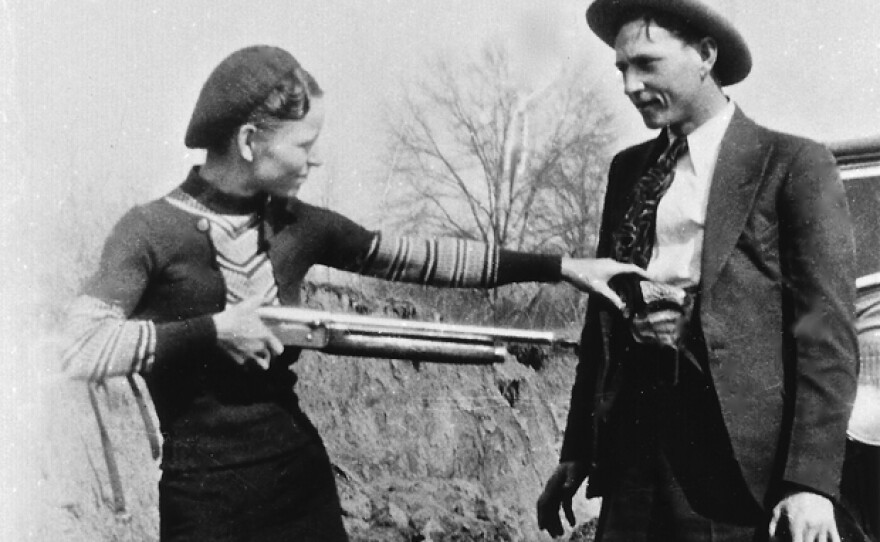Bonnie Parker and Clyde Barrow had been on a year-long crime spree, leaving a trail of dead bodies in their wake, yet were little more than a local curiosity until photos of the couple were discovered at a hastily abandoned hideout in 1933.
The image of a beret-clad Bonnie, cigar in mouth, pistol in hand, striking a defiantly provocative pose, would soon achieve near mythic status.
Overnight, the country became transfixed by the scandalous images and press accounts of their improbable escapes and illicit romance.
Bonnie and Clyde would join the ranks of celebrity gangsters like John Dillinger, ‘Pretty Boy’ Floyd, and ‘Baby Face’ Nelson, ‘public enemies’ who emerged during the Great Depression to capture the country’s imagination.
But their newfound notoriety would force the outlaw lovers to take even greater risks as the hunt to capture them kicked into overdrive.
Told through interviews with cultural historians and descendants of the outlaws and those who captured them, "Bonnie & Clyde," executive produced by Mark Samels and written, produced, and directed by John Maggio, premiered on AMERICAN EXPERIENCE in January 2016.
Clyde Chestnut Barrow was born in the Texas cotton belt on March 24, 1909, one of seven children of itinerant farmers who soon settled on the outskirts of Dallas in a poor backwater slum known as “the devil’s back porch.”
Clyde chafed at the prospect of a life of poverty and picked up the bad habits of his older brother, Buck, who had already settled into a life of petty crime. But the brothers quickly escalated from stealing chickens to armed robbery.
Young Bonnie Elizabeth Parker and her family moved not far from where the Barrows had settled. Petite with blue eyes and strawberry blonde hair, Bonnie excelled at school, enjoyed writing poetry, and was enthralled by the glamour of the movies.
When she met Clyde, sparks flew and the two were soon inseparable.
Soon after, Clyde was arrested and Bonnie smuggled a gun into the jail. Clyde and two other inmates escaped but were caught just days later.
Clyde was sent to one of the most notorious prisons in Texas, Eastham, filled with the system’s most violent offenders. Repeatedly molested by a vicious convict named Ed Crowder, Clyde put an end to the abuse by murdering Crowder. Another inmate took the blame and Clyde was later released.
Vowing never to return to prison, Clyde — along with Bonnie and a revolving cast of ex-cons that would make up the Barrow gang — set out on the open road, burning a path through two dozen states, robbing gas stations, banks, and grocery stores.
But what started out as a thrill ride slowly took a darker turn as Clyde began to employ deadly force more frequently.
From April 1932 to Jan. 1933, Clyde and his gang were responsible for the deaths of four men. By that spring, two new travelers joined the ride: Clyde’s brother, Buck, who was recently paroled from prison, and his wife, Blanche.
In April, the two couples and a young criminal protégé named W.D. Jones took a break from the road and holed up in an apartment in Joplin, Missouri.
When the law caught up with them, they managed to escape the gunfight but left behind their clothes, jewelry, weapons — and rolls of unprocessed film.
The next day, photos of the gun-toting, cigar-chewing sexpot and her handsome leading man were splashed across the front page of The Joplin Globe; soon the images appeared in newspapers and magazines across the country.
The legend of Bonnie and Clyde was born.
In January of 1934, Bonnie and Clyde took part in a raid on Eastham Prison that freed five inmates. It was a satisfying bit of revenge but set off a chain of events that not even the great escape artist Clyde Barrow could elude.
Frank Hamer, the most famous lawman in Texas, was called in to assemble a heavily-armed posse. The shootout lasted only seconds but in the end, the car was riddled with more than one hundred and fifty bullets.
Just a year after Bonnie and Clyde’s deaths, J. Edgar Hoover’s G-men had eradicated all of the Depression era gangsters.
Bonnie and Clyde may have been the first to go down, but the public’s enduring fascination with the legendary outlaw lovers allowed their story to overshadow all the rest.
By Bonnie Parker
They don't think they're too smart or desperate,
They know that the law always wins.
They've been shot at before,
But they do not ignore
That death is the wages of sin.
Some day they'll go down together,
They'll bury them side by side.
To a few it will be grief,
To the law a relief,
But it's death for Bonnie and Clyde.
WATCH ON YOUR SCHEDULE:
This full episode is available to view on demand with KPBS Passport, video streaming for members ($60 yearly) using your computer, smartphone, tablet, Roku, AppleTV, Amazon Fire or Chromecast. Learn how to activate your benefit now.
JOIN THE CONVERSATION:
AMERICAN EXPERIENCE is on Facebook, Instagram, Tumblr, and you can follow @AmExperiencePBS on Twitter. #AmericanExperiencePBS
CREDITS:
AMERICAN EXPERIENCE is a production of WGBH Boston. Executive Producer is Mark Samels. "Bonnie & Clyde" was written, produced, and directed by John Maggio.











